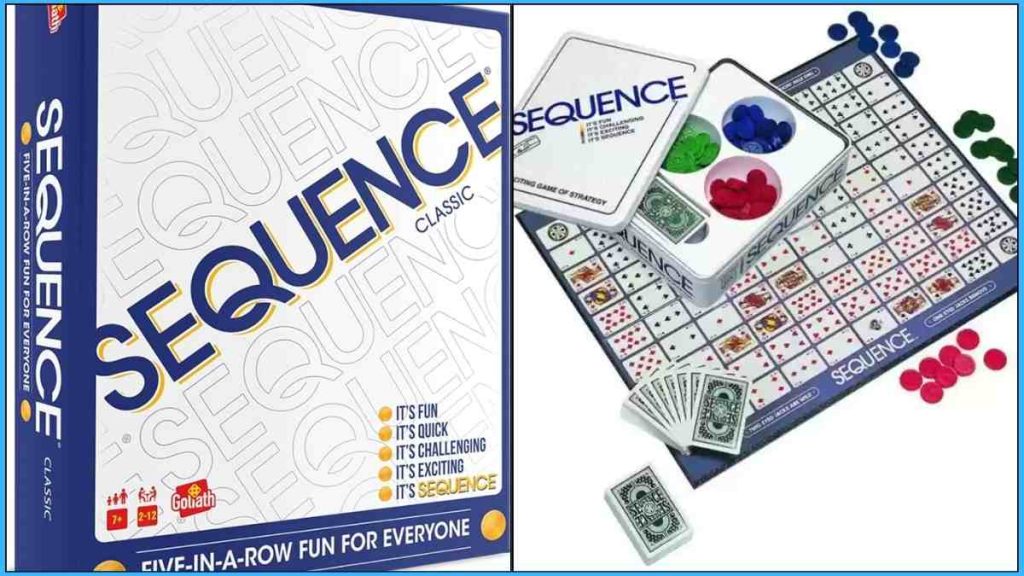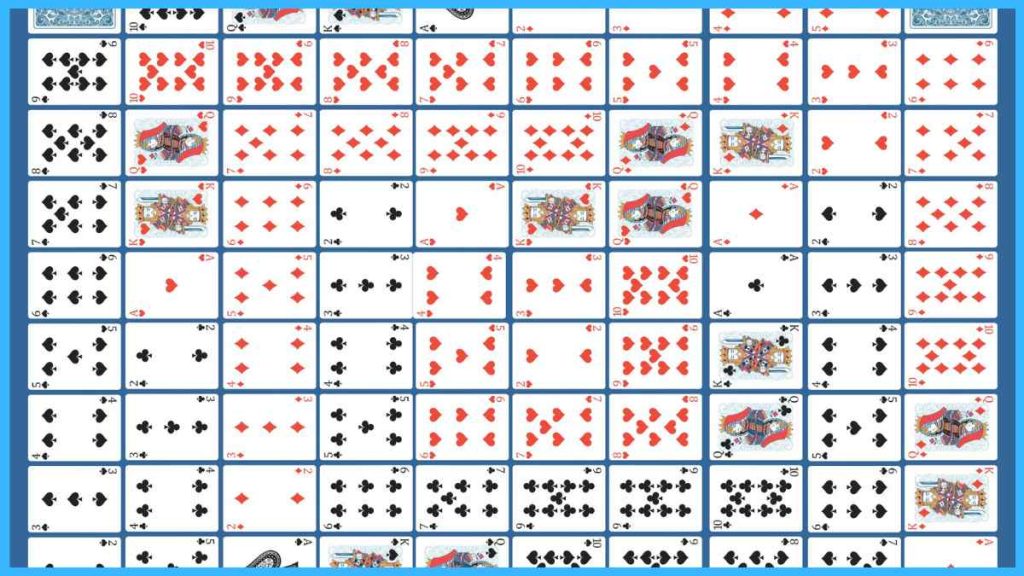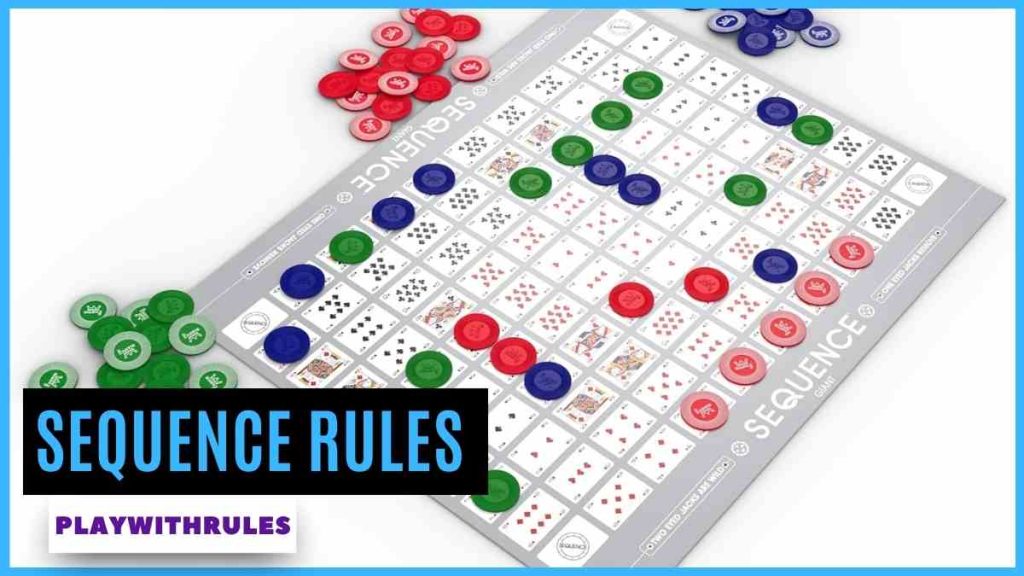Are you ready to learn the highly entertaining and exciting new board game- Sequence? Then, hold your seat tightly. For those wondering what Sequence is, it is an ultra-competitive, incredibly fun, and strategic board game in which you play with teammates. In today’s article, we will discuss the various aspects of this game and explain the sequence game rules.
Objective
The sequence game is relatively simple, which means it’s quite easy to learn. Two or three teams can play this game at one time, and believe us when we say it—things get heated up! Can you handle the pressure? Want to learn this dynamic game? Keep reading!
Table of Contents
Brief History
Sequence was initially named Sequence Five by its creator, who spent years perfecting the concept. In June 1981, Jax Ltd. was granted exclusive rights to produce and distribute the game. A year later, in 1982, Sequence was first sold in retail stores. The game quickly gained popularity and has since inspired multiple variations, making it a favorite among board game enthusiasts worldwide. Its strategic yet simple gameplay continues to captivate players of all ages.
How To Play Sequence Board Game?
Sequence is a board game in which players work as a team to help their team win. A sequence is five chips of the same color lined up in a row. It can be horizontal, vertical, or even diagonal. At the end of the game, the team that has completed the most sequences is declared the winner. Simple, right? But here’s where the fun begins.
The sequence game rules suggest that the game can be played between 2 or 3 teams. However, make sure that the total number of players is divisible by either 2 or 3 (since each team will consist of 2 or 3 players). But how to play Sequence? It’s simple! ‘Sequence’ is played by drawing cards and placing a team’s respective chips at the matching positions on the board.
The objective here is to win. Teams can win by creating more sequences than their opponent. This can mean one of two things: either focus on your game and ‘out-sequencing’ your opponent or sabotage their buildup while creating your own sequences. Either way, the team with the most complete sequences wins the game. But don’t forget to follow sequence game rules while playing your luck.

Setup
Before diving into the details of the ‘How to Play Sequence,’ let’s learn how the game is set, how the cards are dealt, what the sequence game rules are, etc.
- The game begins with cutting cards. A well-shuffled deck of 52 cards is placed face-down. Then, both teams cut the stack wherever they want, alternatively. Then, the value of each bottom card is taken. The player whose bottom card has the lower face value goes first.
- To set up the game, you need a Sequence board, two full standard playing decks (52 X 2 = 104 cards), 50 green chips, 50 blue chips, and 35 red chips (red chips are only used when playing a three-team game).
- According to sequence game rules for two players, players of the same team must sit evenly spaced from their teammates. Let’s say there are two teams of three players each—Team A and Team B. Then, the seating sequence/order of the players would be Team A, Team B, Team A, Team B, Team A, & Team B. Seating would be similar for three teams (Team A, Team B, Team C, etc.) as well.
- The chips are distributed among the players. Let’s assume we are playing a two-team game. Then, the 50 blue and the 50 green chips are distributed between team A and team B players, respectively. This means that Team A will have 50 blue chips in total (equally distributed amongst the players), and Team B will have the green ones (same distribution).
Deal
According to sequence game rules, you cannot play Sequence without playing cards. Two decks of 52 playing cards are distributed between players in this game. Here’s how to deal cards to the players in a game of Sequence:
- For 2 players – 7 cards each
- For 3-4 players – 6 cards each
- For 6 players – 5 cards each
- For 8-9 players – 4 cards each
- For 10 players – 3 cards each
- For 12 players – 3 cards each
Teams & Players
As mentioned before, Sequence is a team game with three-colored chip sets—blue, green, and red. The sequence game can be played between two or three teams, and each team’s total number of players must be divisible by 2 or 3 (3, 6, 8, 9, 10, or 12 players per team). Following so far? Good! Now, let’s take it up a notch and really understand the sequence game rules and how to play sequence.
Sequence Rules
The Sequence board game is one of a kind. It is one of the most fascinating board games you can learn to play. So, without further ado, let us understand the sequence game rules:
- The Sequence board is the most crucial part of the game. It contains 100 card impressions/depictions where players place their chips during the game to create sequences.
- 5 chips in a row (horizontally, diagonally, or vertically) make a sequence.
- The play starts with the player to the left of the dealer. Each player draws a card from the central draw pile. Then, every player must discard a card and place a chip on the corresponding card slot on the board. Say Player 1 draws a 6 of Hearts and discards that. Then, Player 1 must place a chip on the 6 of Hearts slot on the board, per sequence rules.
- Since two card decks are being used, the board consists of two slots of the same cards. In other words, the board features two of every card type, rank, etc., and players can place their chip on any of the two slots.
- Cards are arranged sequentially by order of suit to make it easier for the players to locate cards and their positions.
- If a player has already placed their chip on a particular card slot, you may not:
- a) Replace their chip with yours or
- b) Add your chip to the same slot and share the slot.
- Every player must draw a card from the face-down drawing pile after placing their chip on the board during their turn. If a player forgets to draw a card before the next player plays their turn, the previous player’s turn is skipped, and they have to play with one less card for the rest of the game.
- According to sequence game rules, intersecting sequences are allowed as long as the chips are of the same color. For example, if you have a blue horizontal sequence, you can also have a blue vertical sequence running through the middle of the horizontal Sequence. In this case, both the sequences will have one intersecting common chip. This is allowed. However, you cannot intersect the Sequence of an opposing team or chips of a different color.
- At each corner of the board is a ‘Wild Sequence’, which counts as one chip. This means you need four chips to complete a sequence that begins or ends with the ‘Wild Sequence.’ There are four such Wild Sequences across the board.
- All teams are allowed to share the ‘Wild Sequence’ slots. Simply put, if you have a sequence of four chips and one Wild Sequence, your opponent can also have a non-intersecting sequence that begins or ends with the same Wild Sequence.
- As for the sequence rules for the wild cards, Jacks are not used as regular playing cards in the deck, so there are no Jack slots on the board. Jacks are Wild Cards in Sequence.
- If both eyes of a Jack card are visible, you can place one of your chips on any empty space or card slot on the board. If only one eye of the Jack is visible, you must remove any one chip of the opponent. However, you cannot remove a chip that is part of a complete sequence.
- If a player draws a card but all the respective card slots have been occupied on the board, you may call out ‘Dead Card’ if you want. If you do that, you must discard that card and draw another card from the drawing pile. This will not count as a move, but you get to play that turn, meaning you must place a chip in the slot of the card drawn.
- Discussing strategies, prompting teammates, or communicating discreetly is not allowed in the game. If a player tries to help out their teammate using any mode of communication, then all the team players must choose a card they have to discard. The team members must play with one fewer card for the rest of the game.

Tips & Strategies
Want to get better at Sequence so you can beat all your friends? Here are some tips and strategies that will drastically change your game while playing within the sequence game rules:
- Know when to block and when to create sequences. Your initial objective should be to win by making as many sequences as you can before the opponent does. However, you also need to realize when it is essential to block. If you see that your opponent is about to complete their second or third Sequence, try to use one or more of your chips to block them from completing the sequence.
- Save your Two-Eyed Jack. Don’t use it at the beginning. The two-eyed Jack is a wild card that allows you to place your chip on any empty slot on the board. You can either use this as a game-winning move or to block your opponent from winning. Throw your opponents off and let them think that they are about to win while you slowly create your Sequence. As they are about to win, play your Wild Jack and block their final Sequence to stop their progress.
- Utilize the Wild Sequence corners to save up on chips. If you have the opportunity to build a sequence from the corner, always try to do that. If you use all four corners, then you can save at least 4 chips that you can use to block your opponents. Plus, you can also intersect your own sequences. The key is to save as many chips as possible when making a sequence to use them to block your opponent.
- Spread your game out. Instead of colonizing one side of the board, place your chips on different areas of the board. This will increase confusion and your chances of completing at least one Sequence.
Winning
Sequence is challenging to win while following the tricky sequence rules. Players must be aware of the board while also strategizing their moves and planning how to block their opponent. The first team/player to complete the respective number of sequences required wins. For two players or two teams, two sequences need to be completed first to win. For three players or three teams, one Sequence must be completed to win.
Did You Know?
- Douglas Reute discovered Sequence by mistake. Over the years, the sequence rules and regulations were refined, and in 1970, the game Sequence came into being.
- The Two-Eyed Jack represents a positive potential (placing a chip anywhere on the board), while the one-eyed Jack represents a negative potential (removing one of your opponent’s chips). The two cards represent the wild and the anti-wild nature of the cards.
- The sequence board game is constantly evolving. Today, Sequence accommodates house rules such as increasing the number of complete sequences needed to win.
- The original name of the game was Sequences Five. Back then, completing five sequences was required to win. Today, the modern version of the game requires a team to complete two sequences to win.
- The game was developed over several years and licensed to Jax Ltd. in 1981. It hit retail stores in 1982.
FAQs
How many players can play Sequence Board game?
The sequence can be a singles game or a team game. Two to twelve players can play this game at one time. However, in case it is a team game, the total number of players must be divisible by 2 or 3 (to make teams of two or three players each).
Are diagonal sequences allowed in Sequence?
Yes, diagonal sequences, along with vertical and horizontal sequences, are allowed. However, specific versions allow only diagonal sequences to enhance the game’s competitive and challenging nature.
Can you strategize with your teammates?
Yes, you can, but only before the game begins. During the game, you must not communicate with your partner or teammates in any way, shape or form.
What happens if two teams finish their sequences on the same turn?
In such a case, the team that completes their Sequence first wins the game.
Can you remove a chip from the opponent’s Sequence?
No, you cannot remove any of the opponent’s chips from the set of completed sequences. However, if you have a one-eyed Jack card, you can remove any of the opponent’s other chips (individual and not part of a sequence) from anywhere on the board.
What is the significance of the Joker or the Wild Sequence Space on the board?
The Wild Sequence/Joker spaces on the card are to be left empty. No chips need to be placed there. However, they act as Wild Chips for all teams. In other words, if you include that space, you only need 4 chips in a row to complete a sequence (the Wild Space counts as a chip). Four such Wild Sequences/Jokers are on the board, and all teams can share each.
Now that you know everything there is to know about the sequence game rules, it is time to test out the game! Get your Sequence set and start implementing the tips we have shared with you. ‘Sequence’ is a game that requires players to be patient, tactical, and smart. If you think you fit the bill, then give it a try! Stay tuned to ‘Play With Rules’ for more such fantastic game breakdowns!
Read More: Do you want to know how to play Golf Card Game? Click here

